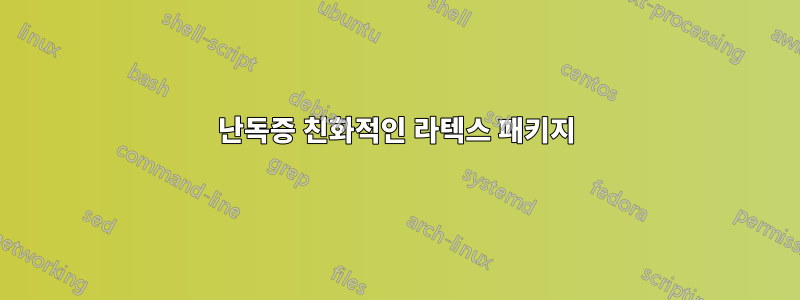
물리 수업을 듣는 난독증 학생이 있는데 그 학생에 맞춰 콘텐츠를 일부 조정해야 합니다. 나는 이것에 대해 조사해 왔지만 그것에 관한 많은 것을 찾을 수 없었습니다.
나는 이미 찾았습니다난독증 글꼴 열기아마도 도움이 될 것입니다. 하지만 단어 사이에 가로 간격을 만들어 달라는 요청도 받았습니다.이렇게 더 넓게.
문서의 타당성에 영향을 주지 않고 전역적으로 수행할 수 있는 방법이 있습니까?
답변1
아래와 같이 단어 사이(및 문장 사이) 공간에 영향을 줄 수 있습니다. 아마도 이를 보완하기 위해 기준선 간격을 늘려야 할 수도 있으므로 그 부분도 보여드렸습니다.
\documentclass[12pt]{article}
\begin{document}
\sffamily
One two three four five six seven eight nine ten eleven twelve.
One two three four five six seven eight nine ten eleven twelve.
One two three four five six seven eight nine ten eleven twelve.
\bigskip
\setlength\spaceskip{.75cm plus .5cm minus .25cm}
\setlength\xspaceskip{1cm plus .75cm minus .25cm}
\renewcommand\baselinestretch{1.2}\selectfont
One two three four five six seven eight nine ten eleven twelve.
One two three four five six seven eight nine ten eleven twelve.
One two three four five six seven eight nine ten eleven twelve.
\end{document}
답변2
댓글에서 언급했듯이,영국 난독증 협회가지고있다스타일 가이드이는 난독증이 있는 사람들에게 적합한 자료를 만들기 위한 좋은 출발점을 제공합니다.
- 의견에서도 언급했듯이 난독증이 있는 학생들은 선호하는 것이 다양하며 이것이 출발점으로 의도되었습니다.
- 난독증 관련 글꼴에 대한 언급이 없다는 점이 흥미롭습니다.
fontspec다음은 스타일 가이드에 맞춰 정렬하는 데 사용하는 문서입니다 . 일치하는 수학 글꼴(TeX Gyre DejaVu Math)과 산세리프 글꼴(Deja Vu Sans)을 사용합니다. fontspec단어 간격을 조정하고 setspace줄 간격을 조정하는 데 사용됩니다.
\documentclass{article}
%\url{https://tex.stackexchange.com/q/715510/86}
\usepackage[scale=.7]{geometry}
\usepackage{amsmath}
\usepackage{fontspec}
\usepackage{unicode-math}
\setmainfont[LetterSpace=2, Ligatures=NoCommon, WordSpace={3.5}]{Deja Vu Sans}
\setmathfont{TeX Gyre DejaVu Math}
\parskip=2\baselineskip
\usepackage{setspace}
\begin{document}
\onehalfspacing
Pythagoras' theorem is often recited as \(a^2 + b^2 = c^2\) and is commonly proven by looking at squares drawn on the sides of a triangle.
This is problematic.
Firstly, the \(a\), \(b\), and \(c\) in the formula have \emph{meaning}.
They are not arbitrary but are the sides of a right-angled triangle.
Moreover, the side \(c\) has to represent the hypotenuse of this triangle.
Secondly, the theorem is not actually related to the concept of area.
It is actually about how similar triangles behave.
In fact, I prefer to rearrange it as follows.
Starting with \(a^2 = c^2 - b^2 = (c + b)(c - b)\), then divide through to get \(\frac{a}{c + b} = \frac{c - b}{a}\).
Or written in ratio form as \(a : c + b = c - b : a\).
\begin{gather*}
a^2 + b^2 = c^2 \\
\int_0^1 \log(x) \mathrm{d} x \\
\sum_{k=1}^\infty \frac{1}{k^2} = \frac{\pi^2}{6} \\
u_n = a + (n - 1) d
\end{gather*}
\end{document}




